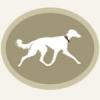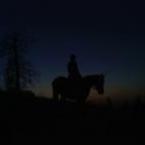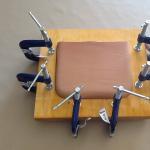-
Posts
256 -
Joined
-
Last visited
About lightingale
- Birthday 10/17/1985
Contact Methods
-
Website URL
http://salukifeathers.com
Profile Information
-
Gender
Female
-
Location
Ontario
-
Interests
Saluki dogs, dog shows, horses, leathercraft, painting
LW Info
-
Leatherwork Specialty
Dog Collars
-
Interested in learning about
Braiding show leads, machine sewing leather
Recent Profile Visitors
9,127 profile views
lightingale's Achievements

Member (2/4)
-
Lol they do have a big dog, but he's friendly. I can't imagine any other dog would work in/around a store! A cable might work, just trying to come up with something a little more elegant looking. This is kind of the direction we're going. I hadn't thought of chain link joints, but that's something we'll play with. From what I'm told, more fiddly = less likely to be stolen, which would be easier on the shopkeep than having to search for a key of some sort. Unfortunately no, these would be OOAK (one of a kind) pieces, with an effort to provide the same design in a variety of sizes. The nature of the exotic leather makes it almost impossible to offer a consistent look across a variety of designs and replenish sold out stock that looks the same. For custom items this will work, and I'm working on a display of tooled veg tan collars for this purpose.
-

Standard sizes for making belts
lightingale replied to Pauls Leather's topic in Leatherwork Conversation
Alpha2 is absolutely correct. Belt thickness affects the size and hooking extras like cases and holders will increase it further. You'll get a feel for how a thin belt would fit and how many inches more you'll need for thicker leather.. you can test it on yourself too! It really helps that your customers are able to try them on. This is a HUGE advantage, and will save you many headaches. However, if they're buying as a gift or you sell online, you still need a reliable standard by which they can measure and still buy a belt that fits. "Belt size" Schmelt size. Go by actual measurements. -

Standard sizes for making belts
lightingale replied to Pauls Leather's topic in Leatherwork Conversation
That's the trouble with belts (and dog collars). It seems like everyone has a different idea on how to measure the length. I'm not sure how "standard" the standard sizes are, but it might help to go to a store with a measuring tape and see how the stated size compares with the actual buckle-tip-to-middle-hole size. From that you can specify that size with the actual crafted size in a way that makes sense. You have to be very VERY clear to your customers on what you mean by your size so someone can measure themselves and be able to buy the appropriate one. Diagrams are your friend. -
While visiting a local exotic animal farm for fun, I discovered they send their hides out to tan and had them on display right at the farm. It's a tourist destination with a gift shop sporting the work of other local artists using the animal products, and we struck a deal whereby I can craft dog collars with their hides to sell right in their shop. The leather is expensive to tan, so the product price reflects that. Since dog collars are a small item, the owner was concerned about how to display them in a way that is resistant to theft. I've only ever sold online so this is something I've never had to think about. Ideas we've had so far: - a display with a thin board at the back whereby the D ring of the collars can fit through a slot, with a nut and bolt holding it in place from the back - a post with holes drilled for dowels that the collars can be displayed on, and attaching a snap on a ring to the D ring that would make it too fiddly and time consuming to remove while the shopkeeper's back is turned. Any suggestions?
-
I'm pretty new to machine sewing (Artisan Toro), and I've been learning by doing. This is my first attempt at a lambskin dog collar. I'm happy with the stitching, the tension is right and the stitches are even. I wrappped the blue lambskin around a 4-5oz veg tan "stabilizer", and then cut another piece of lambskin for the lining to hide the seam at the back. I have two questions: 1. How do I finish the seam? I saw in a Youtube video that someone burned the thread ends with a match. Is that the right way to do it? Should I have attempted to backstitch two stitches (risking not going back exactly into the same holes)? 2. What's the best way to do a lining? I wasn't able to skive this lambskin, as it's incredibly soft. The edges stick out awkwardly and look... bad. How can this be improved? I'm temped to take a fine pair of scissors and try to cut it down as close to the seam as possible, as the glue is not near the edges. What do you think?
-

Bobbin Winder Won't Spin - Artisan Toro
lightingale replied to lightingale's topic in Leather Sewing Machines
Ah, I figured it out. I wasn't aligning the pin with the hole in the bobbin, so the bobbin wasn't in all the way, and jammed up against the trip latch. There was too much friction to spin. I need to stop being intimidated by this machine! Leaving this thread here in case it helps someone else in future. -
I'm still struggling to get the hang of the Artisan Toro 3200. I'm trying to wind my first bobbin, but the winder does not spin. I've followed all the instructions in the manual. I've tried with the "bobbin winder trip latch" both down and up, and it makes no difference. Is there a step I'm missing to engage the bobbin winder? I don't see any lever anywhere to do so. I've attached a photo of the machine.
-
I can attest to this, Scholastica, as I went through the same thing this week on 3oz leather. Thought I was doomed until I put it back in the die and pressed a bit harder.
-
My local leather supplier had this lovely bright red side (an extra from someone's large custom colour order) that I could not resist taking home.. it's unlike anything I've seen before. I think the base leather is from Wickett & Craig. It feels like regular latigo, and I was able to cut a swivel knife pattern on my first project (attached photo). On the invoice, it's listed as "motor latigo". What is that?
-

Backpack Purse
lightingale replied to Randahl's topic in Purses, Wallets, Belts and Miscellaneous Pocket Items
Thanks for the walkthrough! I absoloutely love this look and have been looking into its methodology for dog collars. Did you use a welting foot on your sewing machine to get the stitch line so close to the piping? Or just use a single toe? -

Backpack Purse
lightingale replied to Randahl's topic in Purses, Wallets, Belts and Miscellaneous Pocket Items
This is gorgeous and beautifully put together! Can I ask how you did the straps? It looks like a folded edge with a strip of snake sewn on top? -
In art class, one of my teachers' mantra was "art is 10% talent and 90% hard work". Talent is only a small part of the equation. It's a matter of doing, learning, practice, and experience. And inspiration, as Twin said.
-
You don't need expensive or fancy brushes, the synthetic ones will do just fine. Walmart sells a pack of 10 or so brushes in different sizes. The best shape for detail is the round brush. The end tapers off so you can make fine lines. Round brushes meant for watercolour are my favourite. Be sure to have a separate brush set for blues, reds, yellows, and blacks because it's hard to clean the brush completely of oil dyes, the the "old" colour you last used can bleed into your project the next time you use the brush with a different colour. I find dye reducer to be the best solution for cleaning brushes.
-
After spending a few hours researching it, a source of washers is what would be the difference between buying the jig or not. I'd rather not have to punch and drill each one by hand.










